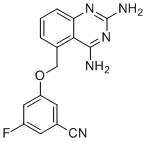
PF-DcpSi
CAS No. 2092917-19-4
PF-DcpSi( —— )
Catalog No. M13280 CAS No. 2092917-19-4
A potent inhibitor of the mRNA decapping scavenger enzyme (DcpS) with IC50 of 0.11 nM; shows no significant activity for DHFR (IC50>30 uM).
Purity : >98% (HPLC)
 COA
COA
 Datasheet
Datasheet
 HNMR
HNMR
 HPLC
HPLC
 MSDS
MSDS
 Handing Instructions
Handing Instructions
| Size | Price / USD | Stock | Quantity |
| 100MG | Get Quote | Get Quote |


|
| 200MG | Get Quote | Get Quote |


|
| 500MG | Get Quote | Get Quote |


|
| 1G | Get Quote | Get Quote |


|
Biological Information
-
Product NamePF-DcpSi
-
NoteResearch use only, not for human use.
-
Brief DescriptionA potent inhibitor of the mRNA decapping scavenger enzyme (DcpS) with IC50 of 0.11 nM; shows no significant activity for DHFR (IC50>30 uM).
-
DescriptionA potent inhibitor of the mRNA decapping scavenger enzyme (DcpS) with IC50 of 0.11 nM; shows no significant activity for DHFR (IC50>30 uM); has in vivo mouse CNS PK profile, shows activity in SMA mouse model by prolonging survival and improving function thereby ruling out lysosomotropism.Spinal Muscular Atrophy (SMA)Preclinical.
-
In Vitro——
-
In Vivo——
-
Synonyms——
-
PathwayOthers
-
TargetOther Targets
-
RecptorOther Targets
-
Research AreaNeurological Disease
-
IndicationSpinal Muscular Atrophy(SMA)
Chemical Information
-
CAS Number2092917-19-4
-
Formula Weight309.304
-
Molecular FormulaC16H12FN5O
-
Purity>98% (HPLC)
-
Solubility——
-
SMILESC1=CC(=C2C(=C1)N=C(N=C2N)N)COC3=CC(=CC(=C3)C#N)F
-
Chemical Name3-((2,4-diaminoquinazolin-5-yl)methoxy)-5-fluorobenzonitrile
Shipping & Storage Information
-
Storage(-20℃)
-
ShippingWith Ice Pack
-
Stability≥ 2 years
Reference
1. J Med Chem. 2017 Apr 13;60(7):3094-3108.
molnova catalog



related products
-
Episyringaresinol
Episyringaresinol is a natural lignan isolated from Kalimeris indica.
-
Salnacedin
Salnacedin (G-201) is a small molecule compound used in the treatment of immune system disorders, skin and musculoskeletal disorders, and can be used in studies of acne vulgaris, dermatitis and psoriasis.
-
PKM2 inhibitor G
PKM2 inhibitor G is a inhibitor of pyruvate kinase.



 Cart
Cart
 sales@molnova.com
sales@molnova.com


